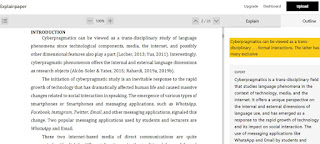In systemic functional linguistics (SFL), monogloss and heterogloss are terms used to describe different types of appraisal resources or evaluative language.
Monogloss: Monogloss refers to the use of a single evaluative resource or a consistent evaluative stance throughout a text. It represents a unified and consistent perspective or attitude expressed by the speaker or writer. In monogloss, there is a coherent and focused evaluation that aligns with a particular position or viewpoint. It creates a sense of stability and uniformity in the evaluative language used. An example of monogloss would be a text that consistently expresses a positive evaluation of a product, such as a review that praises its features and benefits.
Heterogloss: Heterogloss, on the other hand, refers to the presence of multiple evaluative resources or conflicting evaluative stances within a text. It reflects a diversity of perspectives, attitudes, or evaluations expressed by the speaker or writer. Heterogloss allows for different voices, opinions, or evaluations to coexist within a discourse. It often occurs in texts that involve contrasting viewpoints, debates, or conflicting evaluations. For instance, in an argumentative essay discussing the pros and cons of a particular topic, there may be heterogloss as different evaluations are presented and debated.
In summary, monogloss represents a single evaluative resource or a consistent evaluative stance, while heterogloss involves the presence of multiple evaluative resources or conflicting evaluative stances within a text. These concepts help to analyze and understand the complexity and diversity of evaluative language used in communication.
Here are examples of news texts illustrating monogloss and heterogloss in appraisal from the perspective of systemic functional linguistics (SFL):
- Monogloss: Headline: "New Study Shows Significant Decrease in Unemployment Rates" Text: The recently published study reveals a substantial decline in unemployment rates across the country. The findings indicate that the government's economic policies have been effective in generating job opportunities and stimulating economic growth. Experts are optimistic about the future prospects of the job market, considering this positive trend.
In this example, the news text consistently employs a positive evaluation of the study's findings and the government's economic policies. The monogloss reflects a unified and consistent evaluative stance throughout the text, emphasizing the positive impact on unemployment rates.
- Heterogloss: Headline: "Controversial Immigration Bill Sparks Heated Debate in Parliament" Text: The proposed immigration bill has triggered a contentious and polarizing discussion among lawmakers. Proponents argue that stricter immigration regulations are necessary to protect national security and preserve job opportunities for citizens. However, critics claim that the bill is discriminatory and undermines humanitarian values. The debate continues as both sides present contrasting evaluations and passionately defend their positions.
In this example, the news text exhibits heterogloss as it presents divergent evaluations and conflicting viewpoints regarding the immigration bill. The language used reflects a range of evaluations expressed by different stakeholders involved in the debate, highlighting the diversity of opinions and perspectives.
These examples illustrate how monogloss and heterogloss can be observed in news texts, with monogloss reflecting a consistent evaluative stance and heterogloss representing the presence of multiple evaluative resources and conflicting evaluations.








